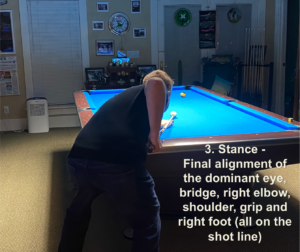 It’s hard to say that any single pool fundamental is more important than another. All mechanics must be perfected, but if there’s one that causes more missed shots than anything else, then alignment stands out.
It’s hard to say that any single pool fundamental is more important than another. All mechanics must be perfected, but if there’s one that causes more missed shots than anything else, then alignment stands out.
Once you’ve learned the correct grip, bridge, stance, and stroke it’s not that hard to execute them and during most shots they will fall into place. But alignment is one fundamental that has a tendency to waiver. This is precisely why you see the best players in the world reinforcing good alignment habits over and over again.
IMPORTANCE OF ALIGNMENT IN POOL
Without proper alignment, your body receives mixed signals from your brain, with regards to your body position and your intended target. If your eyes are looking towards the shot line but your body and cue stick are actually aligned slightly to the left or right, you’ll need to make adjustments in your stroke, which affects how straight you shoot and can also put unwanted spin on the cue ball. This could result in any number of problems: If your body is aimed to the left of your intended target, then without intentionally doing so you’ll stroke to the left of center resulting in unwanted deflection.
 THE ONE DEGREE CAN MEAN A MISS
THE ONE DEGREE CAN MEAN A MISS
To put alignment in perspective, if the cue stick is even a degree off line it can cause a miss of a several inches or more!
ALIGNMENT REQUIRES PRACTICE JUST LIKE EVERYTHING ELSE
It’s important to realize that good alignment takes practice; the same way you practice your stroke. If you get to go to a big tournament, you’ll see most of the players emphasizing alignment to be sure they are spot on.
SO WHAT’S THE BEST WAY TO MAKE SURE YOU ARE ALIGNED?
It’s important to mention here that your body: right shoulder, right hip, right elbow, bridge hand, grip hand, right hip and right foot, all need to be aligned to the shot line if you are right handed and vice versa if you are left handed.
- CHIN LOCK: Stand 4-5 feet away from the cue ball, directly behind it, and trace an imaginary line from the cue ball to the contact point on the object ball. It’s imperative that you stand behind the cue ball to see this line. Trying to find your line while in your stance will create an optical illusion and will almost always, result in poor alignment. I stand behind the cue ball and align my dominant eye and the outside edge of my right foot to the shot line (feet parallel in most instances) so that when I get into my stance the cue will automatically be in the correct position.
- APPROACH: As I fall into my stance, I step towards the shot line and align my dominant eye (or vision center) with the shaft of my cue and aim it directly into the contact point on the cue ball. My right foot is on the shot line and my left foot is parallel.
- STANCE: As I get into my stance my left foot remains parallel to the shot line but may be slightly forward of the right. At this point, your dominant eye (or vision center), bridge, shaft, right elbow and right foot should all be on the shot line. If at any time you feel something isn’t aligned you should get up and start the entire process over.
Now work on this – make it a New Year’s resolution! Do it every time you practice! Get yourself ALIGNMENT PERFECT and make sure good alignment becomes a habit on every single shot you shoot. This will eliminate hundreds of missed shots throughout the upcoming year. When you are truly aligned the shot just has a way of working itself out.


